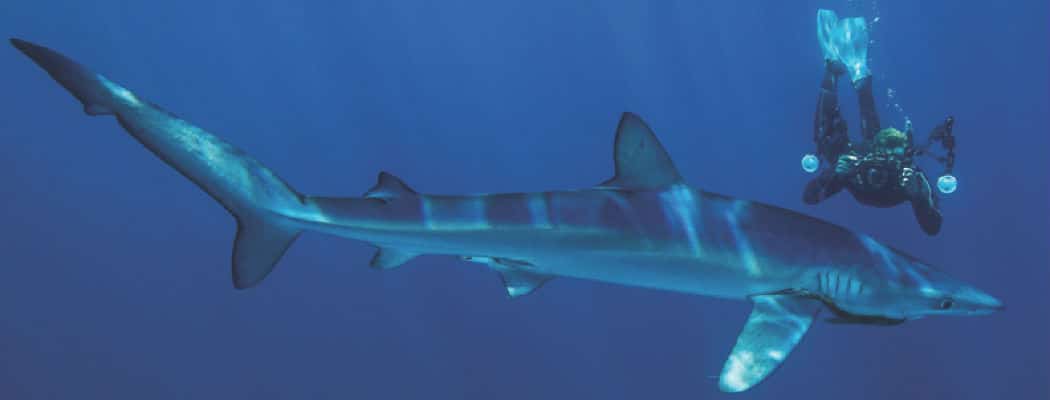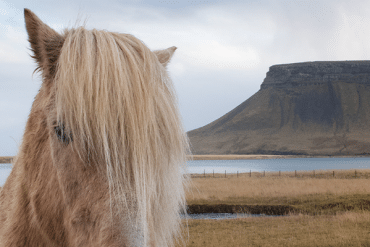Diving deep into one of the world’s most diverse marine habitats off the shores of Nantucket.
 Seventy-five miles due south of Nantucket lies Atlantis, the nearest point of the fabled fishing grounds known collectively as the Canyons. Here the Atlantic plummets abruptly off the continental shelf from six hundred to six thousand feet, and fishermen can encounter more species of marine life than almost anywhere else on the planet. Hammerheads hunt in the tropical water. Schools of yellow fin tuna flee the attacks of blue marlin. Dolphin, mola mola, mahi mahi, manta ray, sperm whales and the largest fish in existence, the 41,000-pound whale shark, slip in and out of the depths. The Canyons are a magical underwater vortex, at once on Nantucket’s radar, and yet also completely off the charts.
Seventy-five miles due south of Nantucket lies Atlantis, the nearest point of the fabled fishing grounds known collectively as the Canyons. Here the Atlantic plummets abruptly off the continental shelf from six hundred to six thousand feet, and fishermen can encounter more species of marine life than almost anywhere else on the planet. Hammerheads hunt in the tropical water. Schools of yellow fin tuna flee the attacks of blue marlin. Dolphin, mola mola, mahi mahi, manta ray, sperm whales and the largest fish in existence, the 41,000-pound whale shark, slip in and out of the depths. The Canyons are a magical underwater vortex, at once on Nantucket’s radar, and yet also completely off the charts.
“It’s one of the last great adventures,” says Eric Savetsky, who’s been seduced by the Canyons for more than fifteen years. “You take off from the dock and you don’t think about anything until you’re back rounding Brant Point.” As much as his schedule as the executive director of the Nantucket Land Bank will allow during the summer, Savetsky launches his thirty-six-foot lobster boat Endurance at dusk and motors through the night to reach the Canyons by daybreak. But unlike the fleets of commercial fishermen he may find there, Eric Savetsky burns thousands of dollars of diesel not to catch fish, but to swim with them.
“I moved out to Nantucket because it had great access to the ocean, but I had no idea how good it was,” Savetsky says, dragging a finger across a chart. “If you look at the geography, we’re the absolute closest point to all the canyons here off Georges Banks.” During the last ice age, the edge of the continental shelf represented the shoreline. When the ice melted and receded, the continental shelf became a hard depth line, the deepest points of which are the canyons.
“The canyons vary in size, shape and morphological complexity,” write Professor Steve Ross and Dr. Sandra Brooke in a study published by the National Oceanic and Atmospheric Administration. “Some were scoured by the flow of rivers during past low sea level periods, but most formed via other erosional processes, such as mudslides, debris flows, and turbidity currents.” Of all the canyons running along the Eastern Seaboard from Florida to Maine, the thirteen off Cape Cod are the least known. And Eric Savetsky is one of the only people out there diving in them.
 “It’s all new exploration,” says island native and professional diver Ben Phillips, one of the few people with enough diving experience and sheer moxie to enter the canyons with Savetsky. “There are very few places that are untouched, that people haven’t really explored,” Phillips says. “And this is definitely one of those spots. Eric is probably the first person to ever document this stuff.” Phillips has spent most of his adult life traveling around the world in search of the most diverse diving, only to find that it was in his backyard this whole time. Now he climbs aboard Savetky’s Endurance at every opportunity he gets.
“It’s all new exploration,” says island native and professional diver Ben Phillips, one of the few people with enough diving experience and sheer moxie to enter the canyons with Savetsky. “There are very few places that are untouched, that people haven’t really explored,” Phillips says. “And this is definitely one of those spots. Eric is probably the first person to ever document this stuff.” Phillips has spent most of his adult life traveling around the world in search of the most diverse diving, only to find that it was in his backyard this whole time. Now he climbs aboard Savetky’s Endurance at every opportunity he gets.
Steaming from Nantucket in the middle of the night, Savetsky and Phillips target both physical structure and thermal structure in the canyons to determine their dive locations. Within a stone’s throw, the water goes from murky green to gin-clear, from a cool fifty degrees to a tropical eighty. The Gulf Stream runs about a hundred miles from the continental shelf, creating warm eddies in the canyons, which churn up nutrients for bait fish to feed on. And where there’s bait fish, there tends to be bigger fish. “You never know what you’re going to see,” Savetsky says. “From something as rare as a whale shark to a thousand common dolphin as far as the eye can see. Or you could see nothing at all. Fishermen have characterized trolling out there as endless hours of boredom broken up by brief periods of pandemonium.”
Entering the water 150 miles or more away from the closest landmass presents its own unique variety of peril. Most of the time, the boat is bobbing so far off shore that it’s almost out of radio range with the Coast Guard. Apart from an emergency satellite phone on board, they’re completely on their own. “I think of my boat as a spaceship,” Savetsky says. “You’re going out to a place where you have to be totally self-reliant.” With the water too deep to anchor, someone must stay on board when Savetsky and Phillips enter the water to keep the boat idling nearby. If the engine fails, the Endurance could be swept up by the current, leaving the two men stranded with a 150-mile swim home. In other words, they’d be dead in the water.
 Of course, the more immediate dangers that come to mind are large predators. The canyons are home to a variety of sharks — makos, tigers, hammerheads. Once, Savetsky was diving with twenty hammerhead sharks along with another dive partner named Tom Burns. The sharks were swarming around the two men, forcing them to swivel continuously in the water to prevent the predators from sneaking up from behind. Suddenly, Savetsky turned again in the water to find a four-hundred-pound tiger shark swimming right at them out of nowhere. “He came six or eight feet away, then turned and left,” Savetsky remembers. “Tiger sharks have a reputation. Great whites, bull sharks, and tigers are the top three man-eaters, if you want to call them that.”
Of course, the more immediate dangers that come to mind are large predators. The canyons are home to a variety of sharks — makos, tigers, hammerheads. Once, Savetsky was diving with twenty hammerhead sharks along with another dive partner named Tom Burns. The sharks were swarming around the two men, forcing them to swivel continuously in the water to prevent the predators from sneaking up from behind. Suddenly, Savetsky turned again in the water to find a four-hundred-pound tiger shark swimming right at them out of nowhere. “He came six or eight feet away, then turned and left,” Savetsky remembers. “Tiger sharks have a reputation. Great whites, bull sharks, and tigers are the top three man-eaters, if you want to call them that.”
For the average landlubber, appreciating the different motivations of these men might be a challenge. It may seem that they’re spending thousands of dollars, motoring away their vacation days and risking their lives for nothing more than a handful of photos. But Savetsky and Phillips are driven by the bigger picture. “From what I’ve seen internationally, it’s a pretty dire situation,” says Phillips. “The ocean does not have a very good future, but this is an area where change can still happen. The last thing I want to see is our waters fall to the same fate as I’ve seen around the world. So it’s very important to document this stuff and get people on board to help preserve it and protect it.”
While our waters may still have a fighting chance, there’s no question that time has taken its toll. “You talk to old timers who have lived on Nantucket for a long, long time about what they saw back then,” Savetsky says. “They could go out during the billfish tournament, and within an hour from Madaket, they would see twenty swordfish on the surface in a day. I’ve only seen two in eighteen years!” Overfishing, population increase, and improved fishing technology have hugely depleted the fish population. “Maybe it will come around,” Savetsky offers. “That’s part of why we do what we do… to turn people on to this stuff and make them more conscious of the wonders
in our waters.”
Join Ben Phillips at the Whaling Museum this August 14th and at the Dreamland on August 25th for a presentation of his underwater photography. Eric Savetsky’s underwater photography was presented this past June at the Maria Mitchell Association, but can be also viewed here.





